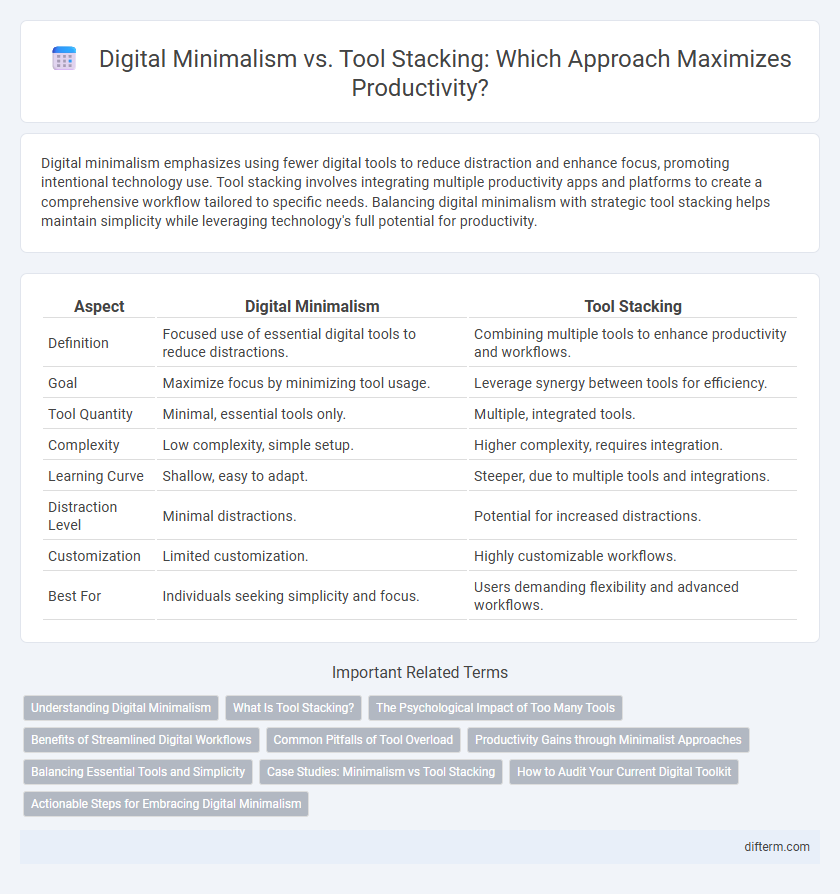Digital minimalism emphasizes using fewer digital tools to reduce distraction and enhance focus, promoting intentional technology use. Tool stacking involves integrating multiple productivity apps and platforms to create a comprehensive workflow tailored to specific needs. Balancing digital minimalism with strategic tool stacking helps maintain simplicity while leveraging technology's full potential for productivity.
Table of Comparison
| Aspect | Digital Minimalism | Tool Stacking |
|---|---|---|
| Definition | Focused use of essential digital tools to reduce distractions. | Combining multiple tools to enhance productivity and workflows. |
| Goal | Maximize focus by minimizing tool usage. | Leverage synergy between tools for efficiency. |
| Tool Quantity | Minimal, essential tools only. | Multiple, integrated tools. |
| Complexity | Low complexity, simple setup. | Higher complexity, requires integration. |
| Learning Curve | Shallow, easy to adapt. | Steeper, due to multiple tools and integrations. |
| Distraction Level | Minimal distractions. | Potential for increased distractions. |
| Customization | Limited customization. | Highly customizable workflows. |
| Best For | Individuals seeking simplicity and focus. | Users demanding flexibility and advanced workflows. |
Understanding Digital Minimalism
Digital minimalism emphasizes intentional use of technology by focusing on essential tools that enhance productivity and well-being, reducing mental clutter caused by excessive apps and notifications. It contrasts with tool stacking, where multiple overlapping digital tools may create complexity and inefficiency. Understanding digital minimalism involves prioritizing quality over quantity in digital resources, leading to streamlined workflows and improved focus.
What Is Tool Stacking?
Tool stacking refers to using multiple digital tools simultaneously or in combination to enhance productivity by leveraging each tool's unique strengths. This approach can streamline workflows, reduce task friction, and improve overall efficiency when carefully curated. Overloading on tools without strategic integration, however, risks creating distractions and diminishing productivity gains.
The Psychological Impact of Too Many Tools
Excessive use of productivity tools in tool stacking often leads to cognitive overload, increasing stress and reducing focus. Digital minimalism emphasizes streamlining tools to enhance mental clarity and boost sustained attention. Studies reveal that minimizing digital distractions significantly improves task efficiency and psychological well-being.
Benefits of Streamlined Digital Workflows
Streamlined digital workflows enhance productivity by reducing cognitive load and minimizing distractions through digital minimalism, allowing individuals to focus on essential tasks. Tool stacking, while offering diverse functionalities, often leads to fragmented attention and workflow inefficiencies. Embracing a minimalist approach with carefully selected, integrated tools promotes faster task completion, clearer project management, and improved mental clarity.
Common Pitfalls of Tool Overload
Excessive tool stacking often leads to digital clutter, reducing overall productivity by causing distractions and cognitive overload. Digital minimalism emphasizes using only essential tools that align with specific tasks, preventing overwhelm and decision fatigue. Common pitfalls of tool overload include fragmented workflows, duplicated efforts, and difficulty maintaining focus on high-priority objectives.
Productivity Gains through Minimalist Approaches
Digital minimalism enhances productivity by reducing cognitive overload and eliminating distractions, enabling users to focus deeply on essential tasks. Tool stacking often leads to complexity and inefficiencies by requiring frequent context switching and managing overlapping functionalities. Embracing minimalist tools streamlines workflows, improves task completion speed, and fosters sustained attention, resulting in tangible productivity gains.
Balancing Essential Tools and Simplicity
Digital minimalism emphasizes using a few essential tools to maximize focus and reduce cognitive overload, while tool stacking involves integrating multiple applications to streamline workflows and enhance productivity. Balancing essential tools and simplicity requires identifying high-impact resources that align with core tasks without creating unnecessary complexity or distractions. Prioritizing functionality and ease of use leads to efficient task management and sustained productivity gains.
Case Studies: Minimalism vs Tool Stacking
Case studies comparing digital minimalism and tool stacking reveal that minimalism often leads to enhanced focus and reduced cognitive overload by limiting distractions and consolidating essential applications. In contrast, tool stacking can increase productivity in complex workflows by leveraging specialized software for distinct tasks, though it risks fragmentation and increased context switching. Data from these studies suggest that the optimal productivity strategy depends on individual work patterns and the complexity of tasks involved.
How to Audit Your Current Digital Toolkit
Conducting a thorough audit of your digital toolkit involves identifying redundant or underused applications and analyzing the impact on your productivity levels. Evaluate tools based on frequency of use, integration capabilities, and alignment with core work objectives to eliminate distractions and streamline workflows. Embracing digital minimalism minimizes cognitive load, while strategic tool stacking ensures essential functionalities complement each other without overwhelming your system.
Actionable Steps for Embracing Digital Minimalism
Embrace digital minimalism by conducting a thorough audit of all your digital tools and eliminating those that do not directly contribute to your core productivity goals. Prioritize high-impact tools by setting strict usage boundaries and scheduling specific times for checking digital communication to reduce distractions. Implement daily rituals such as technology-free periods and batch-processing tasks to enhance focus and streamline workflow efficiency.
Digital minimalism vs Tool stacking Infographic

 difterm.com
difterm.com